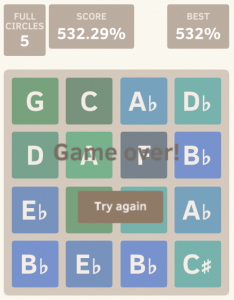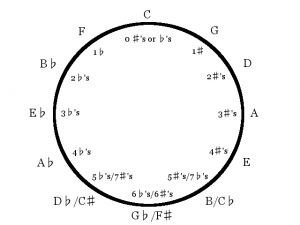
Zach’s high score of 532%
2048 Infinite – The Circle of Fifths is obviously based on the popular game, 2048. However, in using the Circle of Fifths, the game becomes infinite, circular, and almost completely different from the original! With the tiles progressing in a circle, the game becomes mesmerizing. This also means that the score has to be calculated differently. As you play, what was once your high tile will eventually be your low tile. To best reflect your progress in the game, the score is shown in a percentage of full circles completed. If your score is 100%, you’ve gotten one full circle! 200%? Two full circles! I’ve (Zach) gotten past 500% myself. How far can you go?
How do we calculate that score percentage?
Let’s look at an example and I’ll show you how we use all the tiles to calculate a score that reflects the progress in the game. You might have the following tiles on the board: B♭, B♭, A♭, F♯, B, B. Or, listed in a numeric value from counting around the circle of fifths, it would be: 10, 10, 8, 6, 5, 5 (Note: The game actually keeps track of the tiles as numbers like these, and translates them into the appropriate note to display on the screen). One full circle happens when you have made it to the 12th tile. So, with a high tile of 10, the score should be at least 10/12 (83.33%). When we factor in the remaining tiles, the score should be in between 10/12 and 11/12. If we calculate the progress towards a new high tile and add it to 10, we can divide our new number by 12 to get a more accurate score. So let’s use the second highest tile to do that. The progress toward getting a new high tile is the second highest tile divided by the current highest tile. In this case, that is 10/10 (100%). Waitaminute! This leads to a problem: having two of the same highest tiles doesn’t mean you are 100% of the way to a new high tile! Most of the work is done, though, so let’s say that getting two of the same tile is 90% of the work, meaning it should work out to 90% instead of 100%. Our calculation is: 10/10 × 90% = 90%, or 0.9. Add that to 10 to get 10.9 and do 10.9/12 to get a more accurate score: 90.83%.
We can add the third highest tile into the mix, too. Using the second highest tile let us get that 10.9 we used, so let’s use the next tile to add another decimal place onto that and get more precise! The next tile is 8. We can divide 8 by 10, the second highest tile, to get the progress towards getting a new second highest tile. But is that right? To be more accurate, we should calculate it in relation to the current low tile the game is giving. This also means we can just ignore the low tiles on the board because they are not really part of the progress. They’re just handed to you! The low tile at this point is 5, so the calculation is (8-5)/(10-5) × 90% = 0.54. To add it as the next decimal place to the previous number (our 10.9), we do 0.54/10 to get 0.054. 10.9 + 0.054 = 10.954. We can do this with all the remaining tiles to make our number as precise as we can.
That’s a summary of what the game does to calculate the score. Here’s how it looks as the game does everything:
Set of tiles: 10, 10, 8, 6, 5, 5
Progress towards new high tile:
(10−5)÷(10−5)×(9÷10) ⇒ 0.9
+
(8−5)÷(10−5)×(9÷100) ⇒ 0.054
+
(6−5)÷(8−5)×(9÷1000) ⇒ 0.003
= 0.957
Add value of current highest tile:
10.957
Get the score!
10.957 ÷ 12 = 91.31%
After the next move, there is a new high tile. These are the tiles:
F, A♭, F♯, B, B, B
Or, in numbers:
11, 8, 6, 5, 5, 5
Here’s the score calculations for that set of tiles:
Set of tiles: 11, 8, 6, 5, 5, 5
Progress towards new high tile:
(8−5)÷(11−5)×(9÷10) ⇒ 0.45
+
(6−5)÷(8−5)×(9÷100) ⇒ 0.03
= 0.48
Add value of current highest tile:
11.48
Get the score!
11.48 ÷ 12 = 95.67%
 The first two days of the 2048 Infinite Kickstarter have been fantastic! Thanks so much to our (currently) 31 backers who have put us well on our way to making this iOS version of 2048 Infinite – The Circle of Fifths possible. Special thanks to Scott Jon Siegel whose tweet got us an Article at kotaku.com! We ended up having to upgrade our server. Thank you! Technology Tell and Complex Gaming also had kind words to say about 2048 Infinite. Things are going so smoothly that we’ve already decided that we’re going to need some stretch goals.
The first two days of the 2048 Infinite Kickstarter have been fantastic! Thanks so much to our (currently) 31 backers who have put us well on our way to making this iOS version of 2048 Infinite – The Circle of Fifths possible. Special thanks to Scott Jon Siegel whose tweet got us an Article at kotaku.com! We ended up having to upgrade our server. Thank you! Technology Tell and Complex Gaming also had kind words to say about 2048 Infinite. Things are going so smoothly that we’ve already decided that we’re going to need some stretch goals.





